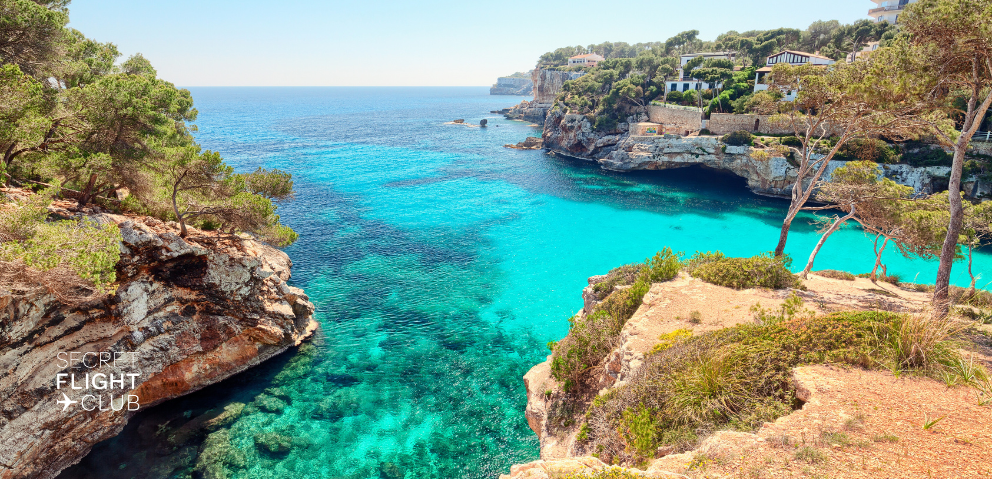Best Spanish Islands: Which One Should You Choose?
25 July 2024

Spain's enchanting islands beckon travellers with their diverse landscapes and rich cultural heritage. From the sun-soaked beaches of the Mediterranean to the volcanic wonders of the Atlantic, these Spanish gems offer a captivating blend of natural beauty and vibrant local traditions. Choosing the best Spanish islands for vacation can be a delightful challenge, as each destination boasts its own unique charm and allure.
This guide takes you on a journey through the most beautiful islands in Spain, exploring the Balearic and Canary archipelagos, as well as some hidden treasures. From the party paradise of Ibiza to the tranquil shores of Menorca, and from the lunar landscapes of Lanzarote to the lush forests of La Palma, there's an island to suit every traveller's taste. Whether seeking a budget-friendly getaway or a luxurious retreat, this comprehensive overview helps holidaymakers make an informed decision about their next Spanish island adventure.
Balearic Islands: Mediterranean Paradise
The Balearic Islands, nestled in the Mediterranean Sea off Spain's eastern coast, offer a captivating blend of natural beauty, cultural richness, and vibrant experiences. This archipelago comprises three main islands, each with its unique charm and appeal.
Mallorca: The Largest and Most Diverse
Mallorca, the largest of the Balearic Islands, is a diverse destination that caters to all types of travellers. Its landscape is a stunning mix of golden beaches, rocky peaks, olive groves, and quaint villages, framed by the Serra de Tramuntana mountain range.
The island's capital, Palma, showcases a vibrant mix of architectural styles. Visitors can marvel at the impressive La Seu Cathedral, a masterpiece of Gothic architecture with a contemporary chapel by Miquel Barceló. The Royal Palace of La Almudaina and the quaint hilltop town of Valldemossa are other must-visit sites.
Mallorca's beaches are a major draw, with over 260 to choose from. Platja de Alcudia is perfect for families, while Cala Llombards offers excellent snorkelling opportunities. For a quieter experience, Platja d'es Carbo is surrounded by sand dunes and pine trees.
The island is also a haven for outdoor enthusiasts. Visitors can enjoy hiking, cycling, horseback riding, and various water sports. Nature lovers will appreciate the Mondragó Natural Park, a treasure trove of forests, ravines, wetlands, and dunes.
Mallorca's culinary scene is thriving, with local chefs reviving traditional recipes. Dishes like sobrasada (a spicy sausage) and ensaimada (a sweet pastry) tantalize taste buds. The island's wine scene is equally exciting, making gastronomic breaks popular year-round.
Ibiza: Party Central and Natural Beauty
Ibiza, often dubbed the "party capital of the world," is renowned for its vibrant nightlife and world-famous clubs. However, this UNESCO World Heritage site offers much more than just parties.
The island boasts stunning natural beauty, with pristine beaches, hidden coves, and lush pine forests. Es Vedra, a mysterious rocky island off Ibiza's coast, provides a breath taking backdrop for sunset views.
Ibiza Town, or Dalt Vila, is a historic gem. Its walled Old Town features steep cobbled streets and narrow alleys leading to a fortress overlooking the city. The town is also home to numerous art galleries, museums, and handicraft shops.
Beyond the party scene, Ibiza surprises visitors with its serene countryside, almond groves, and charming villages. The island has a thriving arts scene and numerous hippy markets, reflecting its eclectic culture and bohemian vibe.
Menorca: Quiet Beaches and Family-Friendly
Menorca, the quieter sibling of the Balearic Islands, is a haven for those seeking tranquility. As a UNESCO Biosphere Reserve, the island offers numerous protected areas, pristine beaches, and clear waters ideal for snorkelling and sailing.
Menorca's coastline stretches for 216 kilometers, dotted with 99 beaches. Many of these, especially on the south coast, feature fine white sand and calm, shallow waters, making them perfect for families with children.
The island is rich in prehistoric monuments, including taulas and talaiots, offering unique insights into the ancient Talaiotic Culture. Mahón, the capital, boasts one of the world's deepest natural harbors.
Menorca's cuisine is a highlight, with its signature Mahón cheese and caldereta de langosta (lobster stew) being must-try dishes. The island's family-friendly atmosphere, combined with its natural beauty and rich history, makes it an ideal destination for those seeking a peaceful Mediterranean getaway.
Canary Islands: Year-Round Sun
The Canary Islands, an archipelago off the coast of north western Africa, are renowned for their year-round pleasant climate and diverse landscapes. These Spanish islands offer a perfect blend of sun-soaked beaches, volcanic wonders, and unique cultural experiences.
Tenerife: Volcanic Landscapes and Beach Resorts
Tenerife, the largest of the Canary Islands, is a captivating destination that caters to various interests. The island's crown jewel is Mount Teide, Spain's highest peak and a UNESCO World Heritage Site. This majestic volcano rises 3,718 meters above sea level, dominating the island's landscape with its otherworldly, red-rock terrain. Visitors can explore Teide National Park through guided tours, marvelling at the lunar-like scenery and enjoying breath taking vistas.
For beach enthusiasts, Tenerife offers a plethora of options. El Medano Beach in the south is a Blue Flag status beach, known for its soft sand and gentle waves. It's also a hotspot for windsurfing and kitesurfing, having hosted world championships in these sports.
Nature lovers will find solace in Tenerife's rural parks. Teno Rural Park in the northwest boasts unique biodiversity, with 13 hiking trails winding through enormous cacti, leafy forests, and vertical cliffs. Anaga Rural Park offers lush forests and historic villages, perfect for those seeking a more immersive natural experience.
Lanzarote: Unique Geology and Art
Lanzarote, often referred to as "The Rock," is famous for its striking volcanic landscapes and artistic heritage. The island's terrain is a mesmerizing blend of lava fields, black and red earth, and whitewashed houses, creating a stark contrast against the deep blue sea and light blue sky.
Timanfaya National Park is Lanzarote's main attraction, featuring the awe-inspiring Montañas del Fuego (Mountains of Fire). Visitors can take guided bus tours through this colourful horizon of volcanic cones and whimsically-shaped rocks, experiencing nature's unique palette of reds, oranges, ochres, grays, and blacks.
The island's beaches offer perfect spots for relaxation, with white or golden sand and crystal-clear turquoise waters. Many beaches are ideal for families, protected from waves and currents, including natural pools formed by lava flows.
Lanzarote's wine industry is a testament to human ingenuity. The La Geria landscape showcases a unique method of grape cultivation, where vines are grown in small pits covered with volcanic ash, which retains night humidity in this arid climate.
The influence of César Manrique, a renowned local artist, is evident throughout the island. His vision combined art and nature, resulting in stunning architectural interventions that enhance Lanzarote's natural beauty. This artistic touch extends to the traditional architecture of villages like Yaiza, which stands at the edge of the area buried by Timanfaya's eruptions.
Hidden Gems: Lesser-Known Spanish Islands
While the Balearic and Canary Islands are well-known tourist destinations, Spain has several hidden gems that offer unique experiences for travellers seeking something off the beaten path. Two such islands, La Palma and El Hierro, stand out for their natural beauty, eco-friendly initiatives, and distinctive attractions.
La Palma: Stargazing and Hiking
La Palma, one of the Canary Islands, is a paradise for nature lovers and astronomy enthusiasts. Known for its stunning landscapes and dark skies, this island offers a perfect blend of outdoor activities and celestial wonders.
The island's commitment to preserving its natural beauty is evident in its network of 16 astronomical viewpoints scattered across the island. These Miradores Astronómicos provide unique perspectives of the night sky, making La Palma a stargazer's dream destination. The Mirador del Llano de Las Ventas, situated at approximately 1,320 meters above sea level in Breña Baja, offers a spectacular panoramic view of La Palma's east coast, ideal for both daytime sightseeing and night time stargazing.
For those interested in history and culture, the Mirador de Buracas combines stargazing with a cultural journey. Located next to the Museo de Interpretación del Gofio, this viewpoint is known for its ancient dragon trees and rock engravings, offering a unique blend of history and astronomy in the northwest part of the island.
Hikers will find La Palma's volcanic landscape, with its lush forests, dramatic cliffs, and black-sand beaches, a perfect playground for exploration. The island's diverse terrain provides excellent hiking opportunities for both beginners and experienced trekkers.
El Hierro: Eco-Friendly Escape
El Hierro, the smallest and most remote of the Canary Islands, is a true eco-friendly escape. Designated as a UNESCO Biosphere Reserve, this island is committed to sustainable tourism practices and offers a unique experience for environmentally conscious travellers.
The island's dedication to sustainability is impressive. In 2014, El Hierro kicked off plans to become the world's first island to produce 100% of its energy from renewable sources. By 2019, 54% of El Hierro's electricity came from wind and water, showcasing significant progress towards this goal.
El Hierro's landscape is a testament to its volcanic origins. Visitors can explore lava fields, volcanoes, and nearly desert spaces, all within a short distance of green meadows and lush forests. The island's diverse ecosystems are connected by well-marked paths, allowing visitors to safely explore and enjoy unbeatable views of the island's charms.
For diving enthusiasts, the Mar de las Calmas marine reserve off southern El Hierro contains some of Europe's most rewarding dive sites. The warm, tranquil waters are best explored in October, offering a unique underwater experience.
El Hierro's cuisine is another highlight, characterized by fresh, local ingredients and influenced by both island traditions and Latin American flavours. Visitors can sample delicious dishes in "bimbachinches," traditional food houses that serve as a reflection of the island's natural environment and rural society.
Both La Palma and El Hierro offer travellers a chance to experience the Canary Islands away from the usual tourist crowds, providing unique opportunities for stargazing, hiking, eco-friendly tourism, and culinary exploration.
Conclusion
Spain's islands offer a diverse array of experiences, from the sun-soaked beaches of the Mediterranean to the volcanic wonders of the Atlantic. The Balearic Islands, including Mallorca, Ibiza, and Menorca, each have their own unique charm, catering to party-goers, nature lovers, and families alike. The Canary Islands, with Tenerife and Lanzarote at the forefront, boast year-round sunshine and stunning landscapes that range from volcanic terrain to pristine beaches.
For those looking to venture off the beaten path, hidden gems like La Palma and El Hierro offer unforgettable experiences. La Palma's stargazing opportunities and hiking trails are a dream for outdoor enthusiasts, while El Hierro's commitment to eco-friendly tourism makes it a standout destination for environmentally conscious travelers. No matter which Spanish island you choose, you're sure to find a perfect blend of natural beauty, rich culture, and warm hospitality to make your vacation truly memorable.

